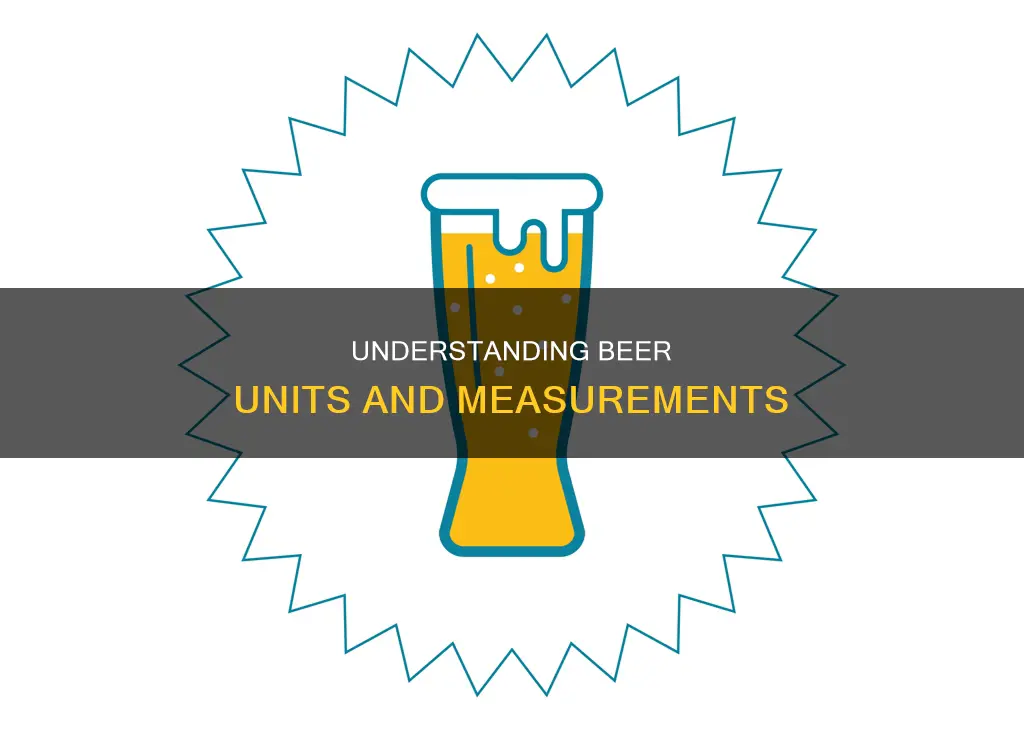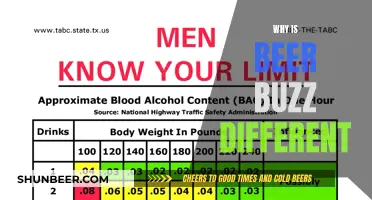
Understanding how much alcohol you are consuming is important for maintaining a balanced lifestyle. Units are a simple way of expressing the quantity of pure alcohol in a drink, with one unit equalling 10ml or 8g of pure alcohol. This is the amount of alcohol that the average adult can process in an hour. In the UK, the standard suggested amount of units per week is 14, spread out across the week, for both men and women. This is equivalent to around 6 pints of 4% beer. To calculate the number of units in a drink, you can multiply the total volume of the drink (in ml) by its ABV (measured as a percentage) and divide the result by 1,000. So, how many units are in a pint of 4% beer?
| Characteristics | Values |
|---|---|
| Number of units in 1 pint of 4% beer | 2.3 units |
| Number of units in 6 pints of 4% beer | 14 units |
| Number of units in 1 pint of 5% beer | 2.8 units |
| Number of units in 6 pints of 5% beer | 16.8 units |
| Number of units in 1 pint of 3.4% beer | 1.9 units |
| Number of units in 1 pint of 7% beer | 4 units |
| Number of units in 1 pint of 9% beer | 5.1 units |
| Number of units in 1 small shot of spirits (25ml, 40% ABV) | 1 unit |
| Number of units in 1 medium glass of 13% wine (175ml) | 2.3 units |
| Recommended weekly alcohol limit in the UK | 14 units |
What You'll Learn

A unit of alcohol is 10ml or 8g of pure alcohol
In the UK, a unit of alcohol is used to measure alcohol consumption and is defined as 10ml or 8g of pure alcohol. This is different from the US, where they use the concept of standard drinks, which contain around 14 grams of alcohol. The UK's definition of one unit of alcohol stems from the fact that this is the amount of alcohol the average adult can process in an hour. Thus, after an hour, there should be little to no alcohol left in the bloodstream of an adult. However, this can vary from person to person.
The concept of a unit of alcohol was introduced in the UK in 1987 to help people keep track of their drinking and understand the relative risks to their health. It is a simple way to express the quantity of pure alcohol in a drink, taking into account both the size of the drink and its alcohol strength. For example, a pint of strong lager may contain 3 units of alcohol, while the same volume of lower-strength lager has just over 2 units.
To calculate the number of units in a drink, you can use the following formula:
Strength (alcohol by volume or ABV) x volume of the drink (in millilitres) ÷ 1,000 = total number of units in the drink
For instance, a pint of 4% ABV beer would contain:
4 (ABV%) x 568 (ml) ÷ 1,000 = 2.3 units
By understanding how many units of alcohol are in a drink, individuals can better monitor their alcohol consumption and make more informed choices about their drinking habits. This is particularly important as excessive alcohol consumption can lead to adverse health effects and an increased risk of accidents and injuries.
It is worth noting that the definition of a standard drink or unit of alcohol varies internationally, and there is no universal consensus on the exact amount of pure alcohol it should contain.
Savoring Sausages: Italian vs. Beer Bratwurst
You may want to see also

A pint of 4% ABV beer contains 2.3 units of alcohol
A unit of alcohol is a metric used to calculate the amount of pure alcohol in a drink. In the UK, one unit of alcohol is equal to 10ml or 8g of pure alcohol. This is the amount of alcohol that the average adult can process in an hour. Therefore, within an hour there should, in theory, be little to no alcohol left in the blood of an adult, though this will vary from person to person.
The number of units in a drink is based on the size of the drink and its alcohol strength. For example, a pint of strong lager contains 3 units of alcohol, whereas a pint of lower-strength lager has just over 2 units.
To calculate the number of units in a drink, you can use the following formula:
Strength (ABV) x volume (ml) ÷ 1,000 = units
Using this formula, we can calculate that a pint (568ml) of 4% ABV beer contains 2.3 units of alcohol:
4 (ABV%) x 568 (ml) ÷ 1,000 = 2.3 units
This calculation can be useful for understanding and tracking your alcohol consumption. It is recommended that men and women should not drink more than 14 units of alcohol per week on a regular basis. This is equivalent to around 6 pints of 4% beer or 10 small glasses of lower-strength wine.
Beer Consumption: Pints Per Hour Explored
You may want to see also

The formula for calculating units is: (ABV x volume in ml) ÷ 1000
The formula for calculating units of alcohol in a drink is:
ABV x volume in ml) ÷ 1000
Here, ABV stands for Alcohol By Volume and is a measure of the amount of pure alcohol in a drink. It is usually denoted as a percentage. For example, a drink with an ABV of 40% means that 40% of its volume is pure alcohol.
The reason for using the above formula is that one unit of alcohol is equal to 10ml or 8g of pure alcohol. This is the amount of alcohol that the average adult can process in an hour. So, the formula helps to calculate the number of units in a drink based on its ABV and volume.
For example, let's calculate the number of units in a pint (568ml) of beer with an ABV of 4%. Using the formula:
4 (ABV%) x 568 (ml) ÷ 1,000 = 2.3 units
So, there are 2.3 units of alcohol in a pint of 4% beer.
It's important to note that the number of units in a drink can vary depending on the size of the drink and its ABV. Different drinks have different standard serving sizes, and the ABV can vary widely even among similar drinks. As such, it's always a good idea to check the ABV and volume to understand how much alcohol you're consuming.
Half-Pint Whiskey: How Many Beers Does It Equal?
You may want to see also

The recommended weekly alcohol limit in the UK is 14 units
In the UK, a unit of alcohol is defined as 10ml or 8g of pure alcohol, which is the amount the average adult can process in about an hour. This is why units are a useful way to keep track of your drinking.
To put this in context, a pint of standard-strength lager or ale with a 4.5% ABV contains 2.5 units of alcohol. A pint of lower-strength lager (ABV 3.6%) contains just over 2 units, whereas a pint of strong lager (ABV 5.2%) contains 3 units.
It's important to note that this 14-unit limit is a recommendation to keep health risks from alcohol at a low level. Drinking more than this amount regularly increases the risks associated with alcohol, including the development of health problems such as cancers of the mouth, throat, and breast.
Understanding Beer Measurements: ML in an Australian Pint
You may want to see also

Drinking more than 6 pints of 4% ABV beer a week exceeds the low-risk limit
In the UK, a unit of alcohol is defined as 10ml or 8g of pure alcohol, which is the amount the average adult can process in an hour. This is different from the US, where a standard drink contains 14g of alcohol.
A pint of 4% ABV beer contains 2.3 units of alcohol. This means that drinking more than 6 pints of 4% ABV beer a week exceeds the recommended low-risk limit of 14 units of alcohol per week.
The UK government recommends that men and women avoid drinking more than 14 units of alcohol per week to keep health risks at a low level. This is equivalent to 6 pints of average-strength beer or 10 small glasses of lower-strength wine.
It is important to note that there is no completely safe level of alcohol consumption. The low-risk drinking limits set by governments are based on levels of alcohol consumption that generally carry only low to moderate risk for the general population. Individuals who do not currently drink alcohol should not start drinking based on these guidelines.
To reduce the risks associated with alcohol consumption, it is recommended to have several drink-free days each week and to spread drinking over 3 or more days if drinking up to the weekly limit.
Mild vs Bitter Beer: Understanding the Taste Spectrum
You may want to see also
Frequently asked questions
There are 2.3 units in 1 pint of 4% beer.
You can calculate the number of units in a drink by multiplying the drink's volume in millilitres by its ABV (alcohol by volume) and then dividing that number by 1,000.
Men and women are advised not to drink more than 14 units of alcohol per week on a regular basis.
It takes the body approximately one hour to metabolise (break down) one unit of alcohol.







